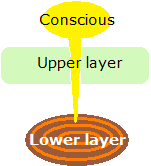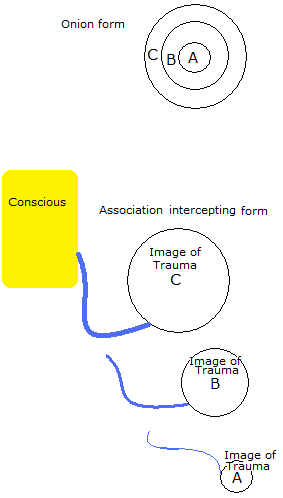The Kuriki method (the first edition in 2007) is a theory about Tourette’s syndrome (tic disorder) and obsessive-compulsive disorder to cure these diseases without medication. This theory is based on the author’s inference and interpretation regarding the structure of these diseases. Since it has been written for the psychoanalysts, reading will be difficult for people in general and it might be sometimes read erroneously. Therefore the Kuriki method must presuppose that the patient is treated by a nearby psychoanalyst, and that, between the patient and the Kuriki method, there is always the psychoanalyst. The explosion of emotional catharsis, which has strong repercussions, is done only for three seconds, once a week: beyond this rhythm, it would be an accident caused by negligence, and the psychoanalyst who is inexperienced in emotional catharsis must take responsibility for the temporary mental collapse caused by the accident. Also, to the patient who has weak capacity of logical reasoning, the psychoanalyst must explain well on the violent emotion of revenge caused by the illusory confusion between the person of the traumatic image in his head and the person in the real world.
Cure for Tourette’s syndrome (tic disorder) and OCD without medication
§34

The mass of emotion is buried in the Unconscious as a thing. It will remain buried for many years until it will be discovered.
Looking for the psychological traumas.
The upper layer is a mechanism that prevents the lower layer to become an object of the Conscious. When you start frequent awareness of indefinite repressed sensations, automatically in the following weeks the traumatic image of the surface of the mass of emotion begins to come to mind. The patient with tic disorder does not need to think if he really has a trauma or not. It is not necessary to believe the existence of the trauma. As long as you have a tic disorder, if you look for your psychological trauma, you will find it. If there are several traumas in the form of an onion, you will find them one by one, going back in time, with catharsis.
In the period of looking for the trauma, an unusual spontaneous action may have an important meaning. For example, usually you do not draw pictures, but today you have spontaneously done ??a little drawing on a paper: this act can be an expression. The key of the trauma may have been expressed. If you took spontaneously a photo, you must observe one by one the things in the photo.
The key for the search for the trauma has no relation to the movements of tic nor the pronounced words of a coprolalia. Also in impulse control disorders,
the act is not an expression with meaning of the cause. It does not indicate the trauma. For example, in trichotillomania, hair is not the key for the trauma searching. The trauma as the cause of nail-biting has no relation to the nails.
The cause of a tic disorder is the presence of a state of repression rather than the content of the trauma. It is the maintenance of a frozen state of a disagreeable judgment. Trauma is the image of any thing of which the intuitive disagreeable judgment has been repressed avoiding a strong disagreeable sentiment in the Conscious. For example, when a primitive bodily sensation has been repressed as something sexually very disagreeable, this sensation can be a trauma in the lower layer. If a primitive bodily sensation has been repressed as an ordinary bodily sensation, this is not a trauma at all.
Also dreams can be a means of research.
List of possible traumas (repression of disagreeable judgment).
Something repeated things as a daily routine : for example,
Nakedness of the father.
Nakedness of the mother.
Nakedness of sisters or brothers.
Touching.
Indeed, whom I love?
Guilt feeling of the sensation of his or her own genitals.
Secret of the erection and the good sensation of male genital part.
Secret of the good sensation of female genital part.
Guilt feeling of sexual things.
Excretion.
A totally unconscious homosexual element.
Homosexual element of the father.
Homosexual element of the mother.
Real homosexuality.
The special physical characteristic of someone.
Oedipus.
etc., etc.
Some things are not listed.
The object of repression is the disagreeable emotion. For example, if a little girl represses the idea; “I don’t want to be touched.”, she doesn’t feel disagreeable to be touched. The image of the fact of being touched will not be repressed. The symptoms of neurosis are means to maintain the isolated state of the disagreeable emotion behind the image.
For example, even if the child watched a dead body at the funeral of a grandfather or a grandmother, without the sexual or genital signification, without repetition, the image will not be connected to the primitive repressed sensation of tic disorder. However, in a ceremonial atmosphere of funeral, and because it is the funeral of a family member, the disgusting emotion for a dead body may be blocked in the head. Normally, we do not show a dead body to very small children. If libidinal trauma is defined as a vital trauma and if the image of a dead body is unconsciously reminded every day, this could be a cause of tic disorder. In addition, it is possible that a sexually and genitally disagreeable emotion would be hidden under an image that easily comes to mind, in the form of an onion.
Even without any sexuality, any genitality, extremely violent traumas can cause a tic disorder as an overflow of fear. These traumas are too much obvious. War, big accident, catastrophe, murder; those extreme cases of posttraumatic stress disorder are beyond the scope of the Kuriki method.

